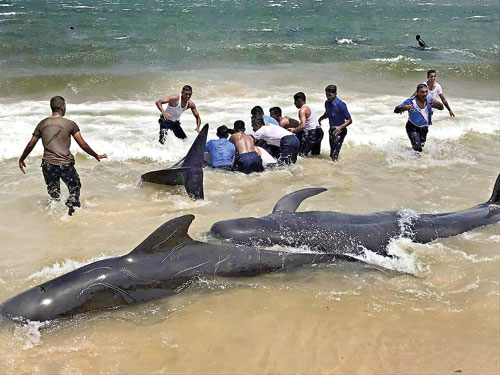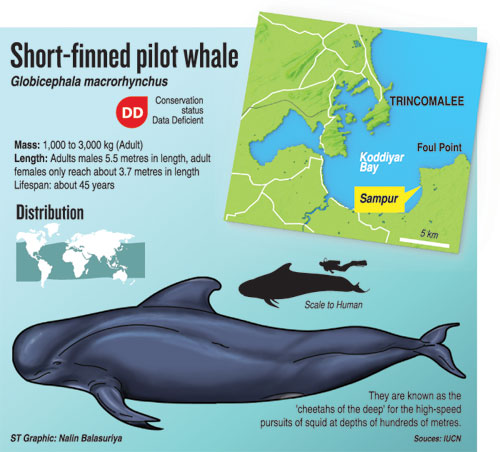News
Sampur pilot whales stranding will remain a mystery
View(s):By Makala Rodrigo
A pod of about 20 pilot whales stranded on Sampur beach in Trincomalee were pushed back to sea last Wednesday by some navymen and locals.
Marine mammal expert Ranil Nanayakkara, identified them as short-finned pilot whales (Globicephala macrorhynchus).
While this is rare in Sri Lanka, there have been occasions elsewhere when pilot whales have run aground.
Mr Nanayakkara points out that in February more than 400 pilot whales washed up on a New Zealand beach.

The pod of about 20 pilot whales stranded on Sampur beach in Trincomalee
Beached whales die due to dehydration, or drowning when high tide covers the blowhole. In some cases, they die by collapsing under their own weight.
Available literature indicates that about 10 species of whales – mostly toothed whales are more prone to being stranded than others.
Why whales get beached in an apparent suicide mission remains a mystery. Many whales use echolocation to navigate, so one theory is that man-made sonar in ships etc. may be interfering with whales and/or natural brain wave activity causing them to become disoriented. Seismic activities on the ocean floor too could be contributory factor.
Most of the whales have close-knit family units, so another hypothesis is that a pod of whales can accidentally become stranded when attempting to come to the aid of a beached whale that is sending out distress calls.
A pilot whale pod can be made up of 20 to 50 individuals, but large super pods with hundreds of individuals too are frequent. They are primarily matrilineal or a female-based society with strong family bonds, so if one swims on to the beach, the others could follow. They have an acute sense of hearing according to marine researchers, making them more prone to stranding. In 1918, over 1,000 pilot whales got beached in New Zealand.
Although the pilot whale’s behaviour resembles that of larger whale species, it belongs to the oceanic dolphin family. Pilot whales are large, robust animals with a bulbous head and no discernible beak. They are black in colour. A male pilot whale can grow up to 5.5 metres (18 ft) in length, whereas adult females are about 3.7 metres (12 ft) in length.
The short-finned pilot whale primarily feeds on squid while certain species of fish and octopus too are included in their diet. They dive deep 300 metres (1000 ft) deep or more in search of prey and spend great lengths of time at depth. Pilot whales are also known as the ‘cheetas of the deep’ for their ability of high speed pursuit of prey deep in the ocean.


